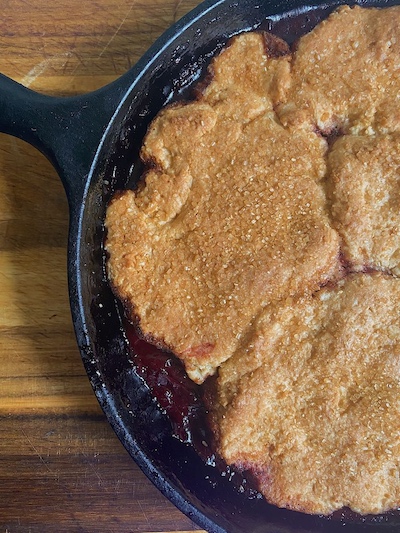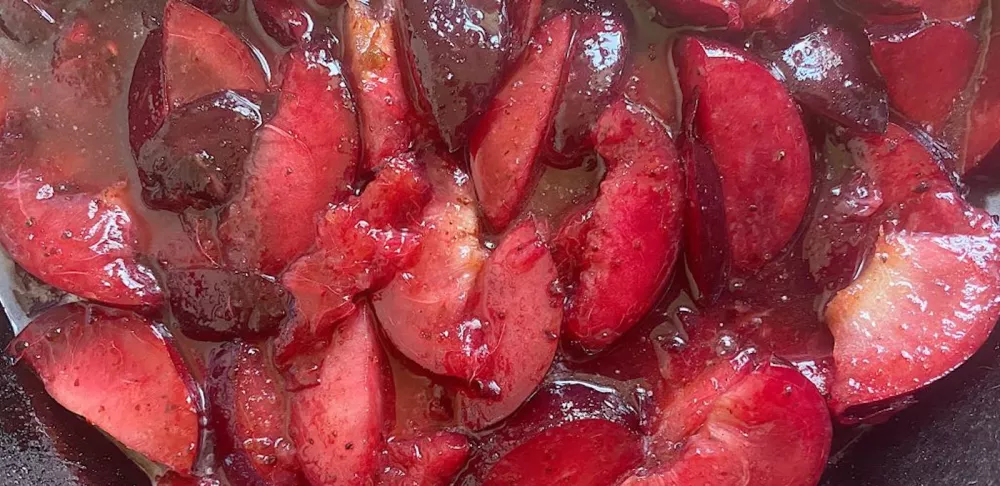ICE alum Adjoa Kittoe shares the story behind Juneteenth and her plum cobbler recipe to celebrate and reflect with red food.
Juneteenth is a day of celebration and reflection, commemorating American history, current events and the future. The amalgamation of “June” and “nineteenth,” recognizes when General Gordon Granger announced the following in Galveston, Texas, on June 19, 1865:
The people of Texas are informed that, in accordance with a proclamation from the Executive of the United States, all slaves are free. This involves an absolute equality of personal rights and rights of property between former masters and slaves, and the connection heretofore existing between them becomes that between employer and hired labor. The freedmen are advised to remain quietly at their present homes and work for wages. They are informed that they will not be allowed to collect at military posts and that they will not be supported in idleness either there or elsewhere.
This historic event is celebrated in 48 states as an official state holiday or observance, beginning with Texas in 1980, and New York City made it an official city holiday in 2020. This week, the Senate and House passed a bill to make Juneteenth a federal holiday, and President Biden signed it into law on June 17.
Many African Americans in the south celebrate with spiritual readings, prayer services, food, red soda water, dances, games, and inspirational messages and speeches. Music, clothing and food are essential for Juneteenth celebrations.
Red food is not purely coincidental, it's intentional, purposeful and meaningful. Red soda, watermelon, red lemonade and red velvet cake are some examples of food consumed during this time. In Africa, red is the color of transformation, regeneration, life, death, strength and spirituality. In West Africa, red also symbolizes sacrificial rites and bloodshed.
For this Juneteenth, I'm celebrating with a plum cobbler, flavored with cured sumac and Ceylon cinnamon. The flavors are similar to a tart cherry pie, and the dessert is bright red like the Juneteenth and Pan-African flag.

Ingredients
 For the filling:
For the filling:
- 8 cups of fresh plums, pitted and sliced
- 2 tablespoons unsalted butter (or plant-based butter)
- 1/4 teaspoon ground nutmeg
- 1/4 teaspoon ground Ceylon cinnamon
- 1 teaspoon ground cured sumac
- 1/2 teaspoon kosher salt
- 1/2 cup light brown sugar
- 1/4 to 1/3 cup granulated sugar, to taste
- 1 tablespoon pear brandy (optional)
- 1 teaspoon vanilla extract
- 2 tablespoons cornstarch + water to dissolve
For the biscuit topping:
- 1 cup unbleached all-purpose flour
- 1 1/2 teaspoons baking powder
- 2/3 cup heavy whipping cream (or plant-based cream)
- 1/3 tablespoon granulated sugar
- 8 tablespoons unsalted butter, cubed and cold (or plant-based butter)
- 1 tablespoon coarse brown sugar, for topping
Directions
- Preheat oven to 400 F.
- In a large mixing bowl, combine the plums, butter, nutmeg, sumac, cinnamon, salt, brown sugar, granulated sugar, brandy, vanilla extract and corn-starch slurry. Make sure not to slice the plums too thin, or they will fall apart during the cooking process. Pour the mixture into a 10-inch cast-iron skillet.
- In a medium mixing bowl, combine the flour, baking powder, salt and granulated sugar.
- Add the butter, and using a fork or pastry cutter, cut in the butter until the mixture resembles a coarse meal.
- Add the cream and stir with a fork just until moistened. Gently press the mixture together using a spatula, forming a loose dough. Crumble the dough on top of the plum mixture. Sprinkle with 1 tablespoon of coarse brown sugar.
- Bake until the top is golden brown and the filling is bubbling, about 30-35 minutes.
- Let the cobbler cool for about 10-15 minutes to allow the juices to sit. Serve the plum cobbler warm or at room temperature, with whipped cream or creamy, frozen dessert. The cobbler topping will soften the longer it sits.
Make more fruit-based desserts in summer recreational classes or Pastry & Baking Arts.




